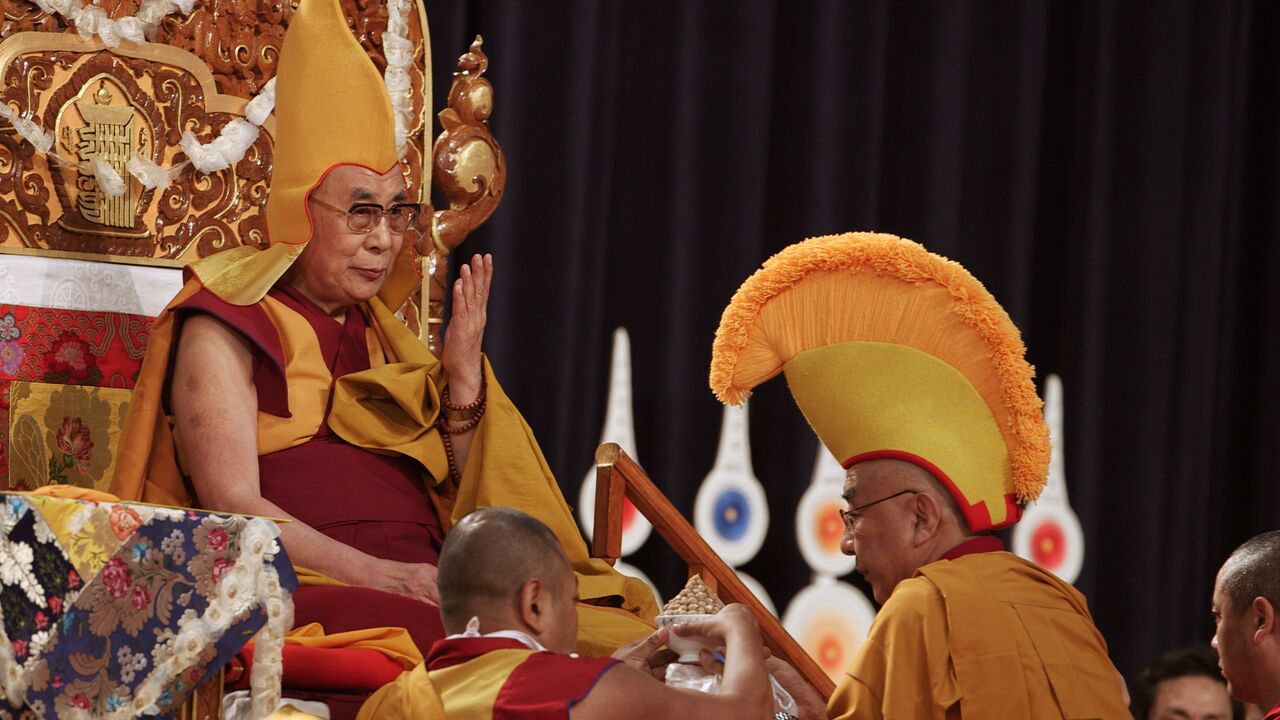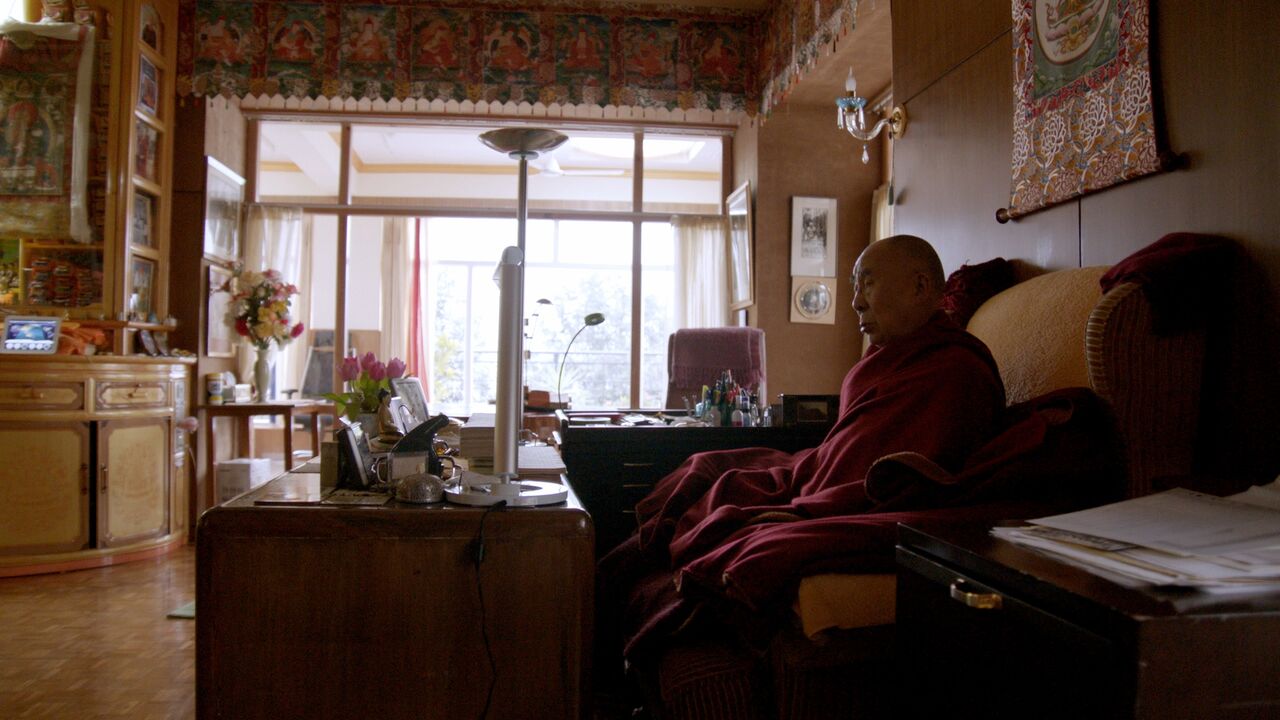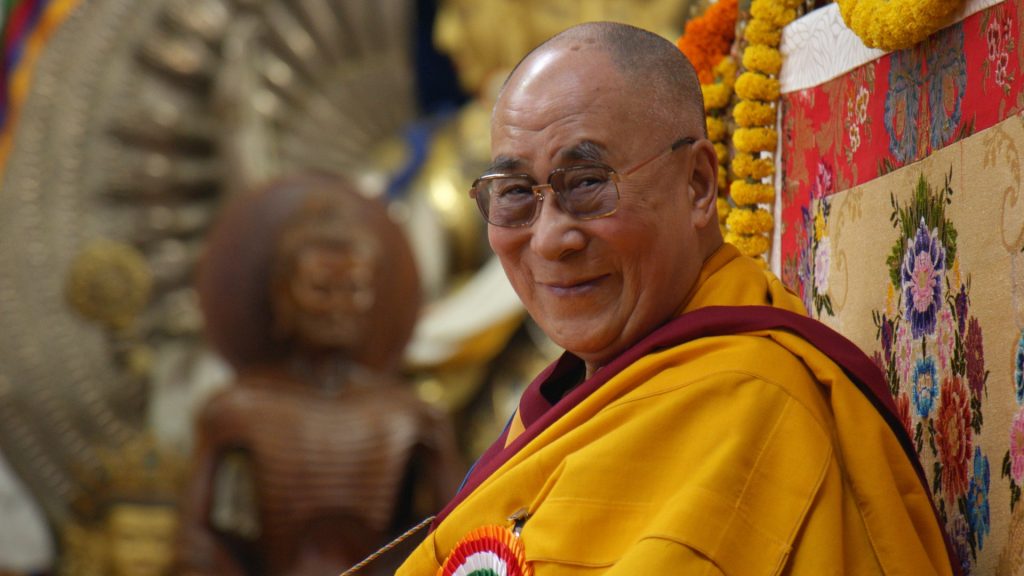In 1979, when His Holiness the 14th Dalai Lama made his first public appearance in North America, at the Cathedral of Saint John the Divine in New York City, practically no one but Tibetans and a few dedicated Buddhist practitioners had a clue who he was—or why he was such a singular force for good. In an endearing moment in Mickey Lemle’s documentary The Last Dalai Lama?, the composer Philip Glass is seated at the cathedral’s organ playing the piece he composed for that occasion. Glass recalls the Dalai Lama being asked, “When do you think about love?” to which His Holiness replied, “I think about love when I think of people, animals, and insects. I’m so moved by insects that when I think of them I’ve been known to weep.” Wide-eyed, incredulous, Glass exclaims, “Insects!”
It’s the kind of surprise, awe, and delight that His Holiness has engendered ever since. The most famous spiritual leader alive today, he’s also probably the most beloved—except by the Chinese. If not all of his fans know that he’s the reincarnation of Chenrezig, or Avalokiteshvara, the bodhisattva of compassion, they are certainly familiar with his unwavering message of love.
Many Westerners got their first close look at His Holiness in Lemle’s 1992 biopic, Compassion in Exile: The Story of the 14th Dalai Lama. A beautiful film, it was the first in-depth view of the Tibetan leader’s life, from his birth in a cow barn in rural Tibet and recognition at age two and a half as the reincarnation of the 13th Dalai Lama through the Chinese takeover of Tibet and his escape to India in 1959, where he established the Tibetan Community in Exile in Dharamsala, the headquarters of his continuing efforts to preserve Tibetan Buddhism and Tibetan culture.

But much has changed in the 25 years since Compassion in Exile came out, prompting Lemle to revisit his subject, with His Holiness’s support. The occasion was the Dalai Lama’s 80th birthday in 2015, celebrated with long life ceremonies in New York and Dharamsala, which are shown briefly in the film. But anyone expecting The Last Dalai Lama? to pick up where the earlier film left off will be disappointed. Compassion in Exile had a story arc that followed the inherent drama of His Holiness’s life. The Last Dalai Lama?, by contrast, is an array of vignettes identifying His Holiness’s current interests. Replacing the sustained narrative of Compassion in Exile are archival footage, historical photos, and interviews from the earlier film intercut—at times with dizzying speed—with recent interviews of His Holiness and a parade of talking heads.
To anyone who has followed the Dalai Lama’s dialogues with scientists and interfaith leaders, and his views on the situation in Tibet and the question of his succession, some of the interviewees will be familiar. They include Thupten Jinpa, His Holiness’s longtime translator, and retired Tibetan Studies professor Robert Thurman, the first Westerner to take vows as a Tibetan Buddhist monk and a close friend of His Holiness for over 50 years, along with more than a dozen others. At least a quarter of the 81-minute film has been lifted intact from Compassion in Exile, including rare interviews with three of the Dalai Lama’s siblings. His brothers’ warnings about the intentions of the Chinese are probably as true today as they were 25 years ago.
Clips from the earlier film along with more recent footage highlight the situation in Tibet. His Holiness’s former chant master, now severely crippled from many years of torture and imprisonment, is asked about the greatest danger he faced during incarceration. “The danger of losing compassion for the Chinese guards and torturers,” he replies. “The Dalai Lama is always saying if you lose compassion, then you’ve lost your soul.” Historical footage of Chinese soldiers brutally beating Tibetans is juxtaposed with recent images of Tibetan protesters self-immolating. By 2015, 166 had died. “Terribly sad,” His Holiness says. “To burn your own body—unthinkable.”

Applying the thousand-year-old mind technology of Tibetan Buddhism to the problems of today is one of His Holiness’s prime concerns. The film highlights his interest in the interface between neuroscience and mind training, showing him in a classroom in British Columbia where “heart-mind learning”—developing compassion and kindness to overcome destructive emotions—is integrated into the grade school curriculum. Daniel Goleman, co-author of Altered Traits and a member of His Holiness’s science “posse,” explains that “one reason education is so important to him is that he takes a long view”—it’s going to take a century to transform the violence and materialism of the current culture, so change must begin with the young.
A related initiative is The Atlas of Emotions, spearheaded by His Holiness with psychologist Paul Ekman, who doesn’t appear in the film, and his daughter, Eve Ekman, who does. In a peculiar editing choice, images from the atlas are flashed on the screen with no introduction or identification—just colorful geometric figures tagged with words like fear, anger, sadness, disgust, and enjoyment. You have to go to the Atlas website to find out that the words and images signify the primary emotions and are key elements of the “map of the mind,” an interactive tool to increase emotional awareness.
Lemle has assembled an interesting cast, and their contributions would be even more effective if the speakers were identified toward the beginning of their comments, rather than midway through or at the end. (Presumably there’s a rationale to this editing choice: the same device was used in Compassion in Exile.) Admittedly, a few voices are hard to miss. When a painted portrait of His Holiness pops up amid still photos of the Tibetan leader, it’s puzzling—until the voice over starts up and you hear the unmistakable Texas twang of former President George W. Bush. Even more surprising are Bush’s revelations about his feelings for the Dalai Lama: “Very few people have had a spiritual effect on me. That’s what makes him so important. The first thing I tried to capture was his lovely nature. I was fascinated by his lips, and pursing his lips, he conveyed a sense of joy.” If a skeptical George Bush can be gobsmacked by the Dalai Lama—he even told Chinese leaders he was surprised they viewed His Holiness as a threat—it’s just more evidence of the life-changing impact the Dalai Lama seems to have on anyone he meets.
Every film begins with a question, Lemle has said—something he’s keen to know. The Last Dalai Lama? is no exception, though more than one question seems to have inspired him here. An obvious one: does His Holiness hate the Chinese? The answer, in a clip lifted from Compassion in Exile, is no. His Holiness describes his lifelong daily practice of tonglen, or taking and giving: he takes the anger, ignorance, and suffering of the Chinese into himself and gives them “positive thoughts” in return. Since the situation in Tibet has worsened, not improved, in the past quarter century, the follow up question is a natural: “Has it worked? Who’s benefitted from your 40 years of that practice?”
“Benefit to myself,” His Holiness shoots back, laughing. “It won’t help the actual problem, but immense help to maintain peace of mind”—key to making better decisions that benefit all.
As for the question posed in the film’s title, Lemle follows His Holiness’s shifting thoughts on the subject, even as the Chinese are tightening efforts to control recognition and installation of all future lamas, not just the Dalai Lama. The film reiterates His Holiness’s position: any future Dalai Lama, if there is one, will be born outside Tibet. He hasn’t ruled out reincarnating, but only “where there are some difficulties or problems, where I can make a contribution.”
To the final question—how is he preparing for death?—the answer, predictably, is practice: “If my mind is clear, I’m quite sure I will remember while I’m dying about altruism for sentient beings.”
The Last Dalai Lama? offers no great revelations. But His Holiness’s presence is always uplifting. And on the deep questions, as usual, he gives us food for thought.
Screening information is available on the film’s website.
Thank you for subscribing to Tricycle! As a nonprofit, we depend on readers like you to keep Buddhist teachings and practices widely available.
